Update: Nikon SB-600 is being replaced by Nikon SB-700
Update: Nikon Speedlight SB-600 vs. Nikon Speedlight SB-700 review
Content |
Nikon Speedlight SB-600 is a compact, yet powerful, flash gun, which is loaded with lots of features. Released in 2004, it gained a lot of popularity and respect among the Nikon users for its consistent performance and high quality.
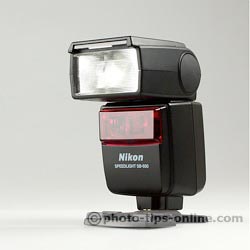 |
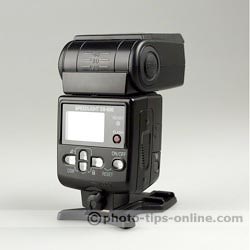 |
The head of the Nikon SB-600 flash turns 180 degrees to the left, but it is limited to 90 degrees to the right, which is typical for flash units of this class. 180 degrees both ways is usually more desirable since it increases your bouncing options, but this capability is usually available on more expensive units.
Zooming is possible in the range of 24-85mm with manual extension to 14mm if the build-in wide-angle panel is used. The lack of 105mm flash zoom setting is due to the smaller size of the flash head, which allows the flash to be more compact.
Similar to its Canon counterpart, Nikon SB-600 does not have a built-in catchlight card. So, to add fill light when bouncing or improve the catchlight, you would need to use an after-market bounce card or some other kind of flash diffuser.
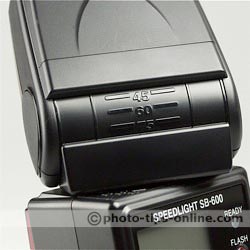 |
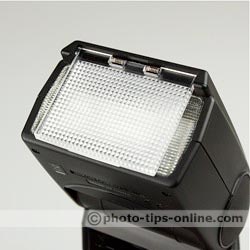 |
LCD is reasonably sized. The layout of the menus is clean and easy to follow. The symbols are readable and easy to understand.
There is no "backlight" button to light the display up in dim lighting conditions. Instead, the backlight can be activated via a custom function. This, of course, is far from a single click operation. So, once you set the backlight to "ON", you will most likely keep it at this setting. This may shorten the life of flash batteries, but it shouldn't be a real issue for the majority of users.
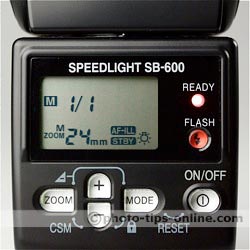 |
The buttons on SB-600 Speedlight have a nice tactile feeling. The space between the buttons and their size make them equally convenient to use for people with small and large fingers. Additionally, the buttons are backlit, too (when the LCD backlight is activated), which can be helpful in the dark.
The Ready light on SB-600 is too bright in our opinion. Sure, you can easily tell when the flash unit is fully recharged, but in dim light conditions the Ready light can be hard on the eyes. The image below shows its relative brightness to other controls on the flash.
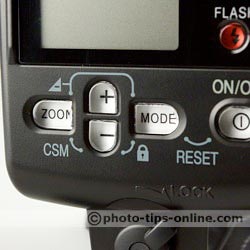 |
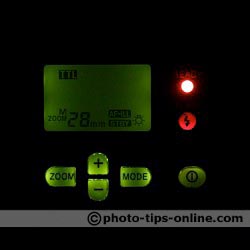 |
Nikon SB-600 does not recycle silently, like more recent flash units, and, therefore, can potentially a source of disturbance when shooting in quite environments. This typically is more important for professional photographers, but for the hobbyists, it shouldn't present a problem.
Recycling time varies depending on the type of batteries being used with the flash. Generally, it ranges from 3 to 4 seconds for this unit, which is quite good.
Please note, that there is no external power connection available on Nikon SB-600 Speedlight, which could reduce the recycling time even further.
The battery compartment door is well-designed. It's easy to open and close, and it won't get in your way when you need to swap your batteries quickly.
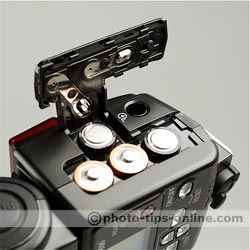 |
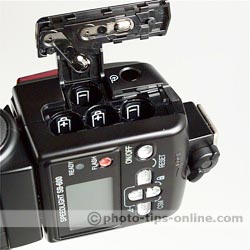 |
Besides the standard i-TTL (the subject is automatically illuminated by the flash), Nikon SB-600 also supports i-TTL BL (balanced fill light). i-TTL BL ensures that the whole scene is properly illuminated (not only the subject you focus on). It is done by balancing the ambient and the flash light.
The images below show the difference between standard i-TTL (left) and i-TTL BL (right). The results may vary depending on the scene you shoot.
 |
 |
Nikon SB-600 emits light of a special pattern in a low light situations to assist camera with focusing. The pattern is projected on the subject prior to the shot. In some cases, it can be undesirable (it can interfere with other photographers' works, for example), so the autofocus assist feature can be disabled in the custom functions menu.
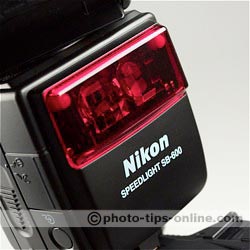 |
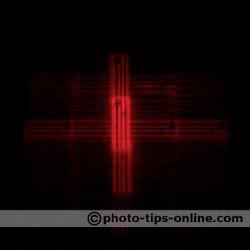 |
Due to the limited number of buttons on the body of the flash, the functions that are not intended to be used frequently are put in the custom setting menu. Holding "Zoom" and "-" buttons for 2 seconds takes you to that menu.
The custom function menu is designed better than similar menus of some other brands on the market (compare to Canon, for example). The Nikon menu shows you symbols that are intuitive, unlike some other flash units that only show a number for each function and a number for each value of the function.
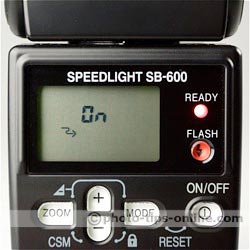 |
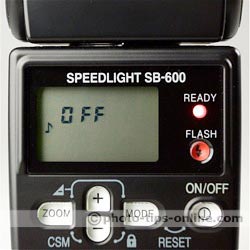 |
Nikon Speedlight SB-600 can be used as a wireless slave flash within Nikon's proprietary wireless system (CLS - Creative Lighting System). When remote, the flash power can be set manually (Manual mode) or automatically (TTL mode).
Remote mode is activated via custom functions menu. There you can also enable the "ready sound". When flash is fully recharged, it will inform you with a beep. (Please note this feature is not available when the flash is used on camera.)
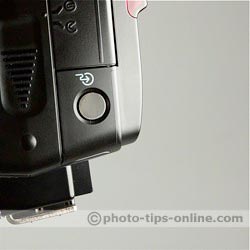 |
PC sync port is also missing on SB-600, so it cannot be connected directly to the radio slaves that use PC interface. With the introduction of RadioPoppers and PocketWizard FlexTT5, however, this is less of a problem now since these radio transceivers use hot shoe for communicating with the flash.
Speedlight SB-600 features a metal mounting foot, which is highly resistant to wear. The only possible drawback is that being so rigid, it is likely to damage the camera's hot shoe in case of an impact. This is a minor observation, but accidents do happen, and in those cases, it is typically cheaper to repair a flash than a camera.
Lever lock is also a very nice touch. It makes attaching and releasing the flash a breeze.
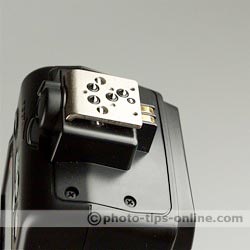 |
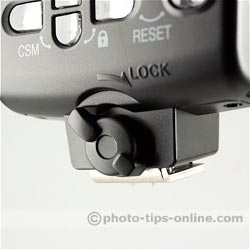 |
| Guide number (ISO 100, zoom head at 35mm) | 30m (98ft) |
| Recycling time | Approx. 3.5 seconds (manual, w/R6 (AA), 4.0 seconds (Lithium Ion AA), 2.9 seconds (NiCd AA), 2.5 seconds (Ni-MH AA) |
| Modes | i-TTL, D-TTL, TTL (film based), Balanced Fill-Flash, Manual |
| Head zoom | 24mm to 85mm, 14mm with wide-angle panel |
| Head swivel | from -90 to +180 degrees |
| Head tilt | from 0 to +90 degrees |
| Bounce card | No |
| Wireless capabilities | Remote (Slave), 4 channels, 3 groups |
| High-speed synchronization | Yes |
| Second curtain synchronization | Yes |
| Modeling light | Yes |
| Weight (no batteries) | 300g (10.6 oz) |
Nikon Speedlight SB-600 comes with a high quality case and a flash stand. The case can accommodate both the flash and the stand, so you can always have the stand with you and use it for remote flash operations when necessary. The case also features a belt loop, which can come in handy.
It also worth mentioning that the thread on the bottom of the stand is metal, which is important if you intend to use the stand to mount the flash on a light stand. Plastic thread would be easy to damage when screwing the stand on.
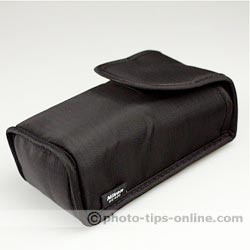 |
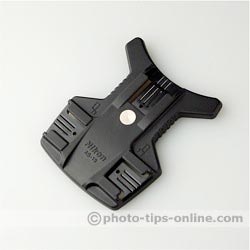 |
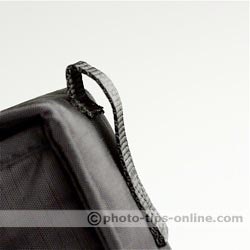 |
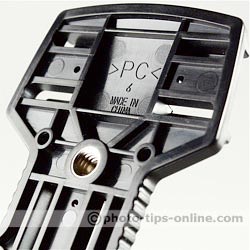 |
Nikon Speedlight SB-600 is a high quality, durable, and reliable flash. It is compact and is more suited for travel than the higher end models. Its interface is well thought through, and, as a result, the flash is easy to operate. The flash has a broad range of features including TTL modes, manual mode, second curtain and high speed sync modes, remote operation, and more. Despite being slightly limited in zoom range and having extra bright Ready light, Nikon SB-600 flash can be a great choice for many photo hobbyists and even professionals.